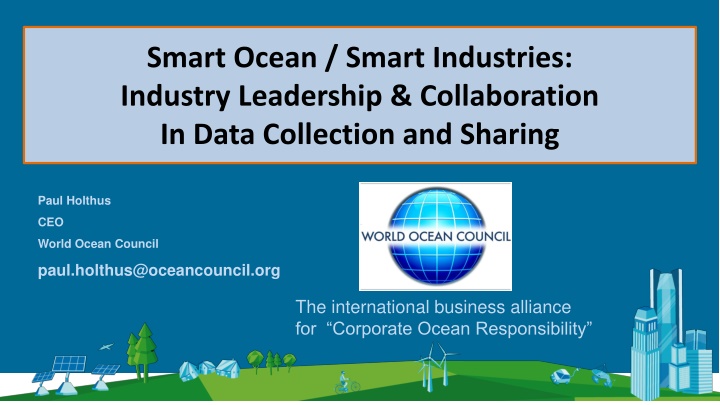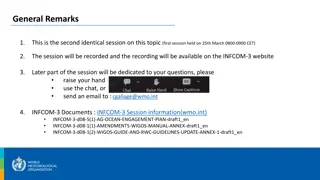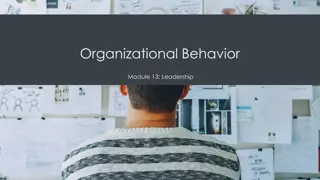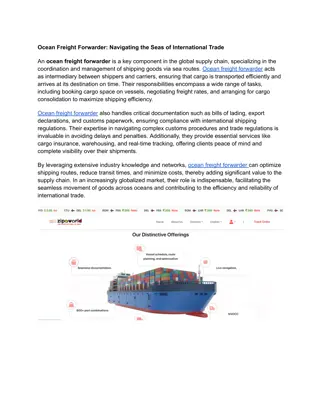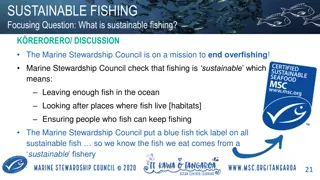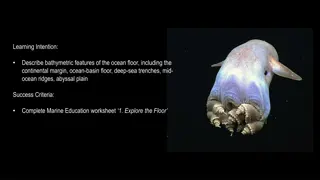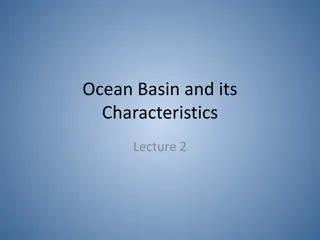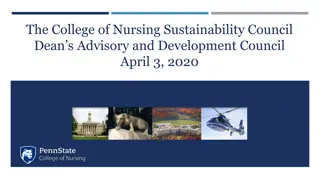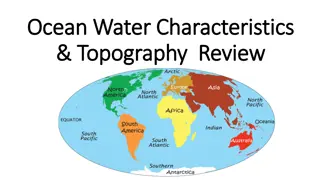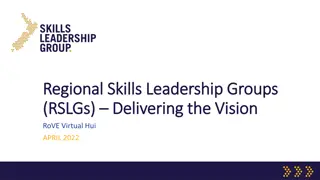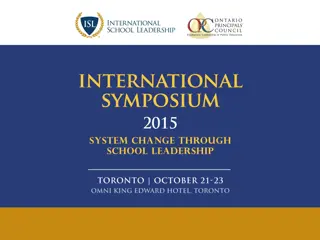World Ocean Council: Industry Leadership and Collaboration for Sustainable Ocean Business
The World Ocean Council is an international alliance promoting leadership and collaboration among ocean industries for sustainable use and stewardship. By bringing together various sectors like shipping, oil/gas, fisheries, and tourism, the council aims to create a responsible ocean business community focused on addressing ocean sustainability. Through shared data collection, synergy building, and operational stability, the council works towards a healthy and productive global ocean while creating business value for its members.
Download Presentation

Please find below an Image/Link to download the presentation.
The content on the website is provided AS IS for your information and personal use only. It may not be sold, licensed, or shared on other websites without obtaining consent from the author.If you encounter any issues during the download, it is possible that the publisher has removed the file from their server.
You are allowed to download the files provided on this website for personal or commercial use, subject to the condition that they are used lawfully. All files are the property of their respective owners.
The content on the website is provided AS IS for your information and personal use only. It may not be sold, licensed, or shared on other websites without obtaining consent from the author.
E N D
Presentation Transcript
World Ocean Council Smart Ocean / Smart Industries: Industry Leadership & Collaboration In Data Collection and Sharing International, Cross-Sectoral Business Leadership Alliance Paul Holthus CEO World Ocean Council paul.holthus@oceancouncil.org The international business alliance for Corporate Ocean Responsibility
World Ocean Council International, Cross-Sectoral Business Leadership Alliance Bringing ocean industries together, e.g. shipping, oil/gas, fisheries, aquaculture, tourism, offshore renewables, etc. Catalyzing leadership and collaboration in addressing ocean sustainability - Corporate Ocean Responsibility Goal A healthy and productive global ocean and its sustainable use, development and stewardship by a responsible ocean business community Creating business value for responsible companies Access and social license for responsible ocean use Synergies and economies of scale in addressing issues Stability and predictability in ocean operations
World Ocean Council: Members Almi Tankers S.A. A.P. Moller-Maersk A/S Arctic Fibre Baird Publications Battelle Memorial Institute Beveridge & Diamond, P.C. BigBlueStuff Birds Eye Igloo Blank Rome BP Cape Breton University Cape Cod Commercial Hook Fishermen s Assn. Global Trust Certification Golder Associates Guangxi Penshibao Co., Ltd Heidmar, Inc. Hepburn Biocare Holman Fenwick Willan LLP Hull Surface Treatment Hydrex Intl Chamber of Shipping (ICS) Intl Tankers Owners Pollution Fed. (ITOPF) JASCO Applied Sciences L3 MariPro Ocean Nourishment Ocean Peace Inc. OceanNetworks Canada OneOcean PanGeo Subsea Powerboat P1 RightShip Rio Tinto Royal Greenland A/S Sanford Limited Shell Shipping HK Forum Ltd Caris USA Inc. China Navigation Company/Swire Pacific Offshore CSA Ocean Sciences Inc. Det Norske Veritas (DNV) EcoStrategic Consultants EDP Renewables Eniram ESRI Executive MBA in Shipping/Logistics ExxonMobil FOB Lloyds Register Louisbourg Seafoods Sinclair Knight Merz Southall Env tal Assoc (SEA) M3 Marine (Offshore Brokers) Pte Ltd Manson Oceanographic Marinexplore Marine Acoustics, Inc. Mitsubishi Heavy Industries Nautilus Minerals, Inc. Noble Group Limited N America Marine Env t Protection Assn. SubCtech Tai Chong Cheang (TCC) Steamship Co HK Teck Resources TierraMar Consulting TOTAL Total Marine Solutions Twin Dolphins Univ. Texas Marine Science Inst. Zodiac Maritime
Priority Areas for Collaboration 1. Ocean Governance o Convention on Biological Diversity (CBD); UNCLOS 2. Marine Spatial Planning (MSP) o EU; US; Australia; international waters 3. Operational Environmental Issues o Sound and Marine Life o Biofouling and Marine Invasive Species o Marine Mammal / Industry Interactions 4. Regional Ocean Business Councils o Arctic; Trans-Atlantic; Mediterranean ; Arab Gulf; SE Asia 5. Smart Ocean / Smart Industries o Observations and Data from Ships/Platforms of Opportunity 6. Sea Level Rise o Port/coastal infrastructure adaptation
1. Ocean Governance Convention on Biological Diversity (CBD) Ratified by 193 countries Conference of Parties (COP) every 3-4 years Conservation and sustainable use of species / ecosystems Primary vehicle for marine conservation policy-making for EEZs and Areas Beyond National Jurisdiction (ABNJs) COP 7 and 8 developed targets for conservation of at least 10% of each of the world s marine / coastal ecoregions COP 9, 10 and 11 approved and advanced work on Ecologically / Biologically Significant Areas (EBSAs) EIA for human activities in international waters
Ecologic./Biologic. Significant Areas 2007 Expert Workshop on Ecological Criteria and Classification - No industry presence 2008 COP 9 adopted scientific criteria for identifying EBSAs in need of protection and scientific guidance for selecting MPA network - No industry presence 2009 Expert Workshop on Scientific and Technical Guidance in Identification of Marine ABNJs in Need of Protection - WOC is only industry presence 2011 COP 10 decision to accelerate identification and protection of EBSAs in high seas - WOC is only industry presence 2011-12 CBD regional workshops to identify EBSAs using CBD criteria - No industry presence; many EBSAs proposed 2012 Preparatory Meetings/COP 11 - WOC presence; many EBSAs approved
Ecologic./Biologic. Significant Areas Areas meeting CBD criteria for EBSAs and proposed for inclusion in EBSA register e.g. Sargasso Sea Alliance
Marine Protected Areas The high seas/deep seabed ocean governance agenda is moving rapidly Significant implications for ocean industries Targets of 10-40% of marine environment for protection
EIA for Activities in Marine Areas Impacts of Human Activities on Marine/Coastal Biodiversity Governments have developed guidelines for biodiversity in EIAs in marine and coastal areas to: Minimize and mitigate the specific and cumulative negative impacts of human activities on biodiversity Identify and assess threats to marine biological diversity Stop the degradation and loss of important habitats Prevent significant adverse effects by unsustainable human activities in marine and coastal areas Support the maintenance of the conservation status of EBSAs and MPAs and avoid their degradation or destruction
CBD UNGA UNCLOS UN General Assembly (UNGA) ad-hoc open-ended, informal Working Group on conservation/sustainable use of marine biodiversity in ABNJ (BBNJ) Before the end of UN General Assembly 69th Session: Urgently address conservation and sustainable use of BBNJ Decide on the development of an international implementing agreement under UNCLOS to address: o Establishing of MPAs o Conducting of EIAs in ABNJ o Ensuring access and benefit sharing of marine genetic resources Consideration of: o Identification and selection of conservation measures for EBSAs o Regional groups identification of MPAs in ABNJ o Activity types to be regulated; establishing enforcement measures
2. Marine Spatial Planning (MSP) Allows a more strategic, pro-active approach to planning Promotes rational use of marine space and resources and sustainable development of maritime regions Involves all stakeholders and maps their interests and uses Coordinates among sectors/users to achieve agreed upon goals and objectives Seeks to balance economic use and conservation Enables early identification of potential conflicts before considerable investment or damage has occurred Provides greater certainty in acceptable locations for different types of use Improves understanding and consideration of the cumulative effects of different activities
The sea is a busy place with many stakeholders Tourism Oil & gas Mariculture Coastal defence Ports & navigation Military activities Culture Conservation Fishing Submarine cables Renewable energy Marine recreation Mineral extraction Dredging & disposal 12
Competition for Seabed Space Seabed congestion is increasing with more stakeholders vying for the best seabed space due to: Increasing development of submarine cable infrastructure Continuing development of offshore energy on the continental shelf and into deeper water Offshore renewable energy development Development of offshore power grids Growing impacts from subsea minerals mining Coastal infrastructure developments Marine parks Protection of marine habitats and designated sites of habitat concern
Competition for Seabed Space There are multiple levels of stakeholders with conflicting interests Economic interests Regulatory objectives Political considerations Environmental interests Resolving issues requires: Knowing stakeholders to engage with Early engagement with stakeholders with the objective of Cooperation rather than competition
Resolving Stakeholder Conflicts Resolving stakeholder conflicts requires effective engagement with all interested parties The ICPC through working groups and subcommittees has been effective in initiating engagement with and resolution of issues The World Ocean Council working with the submarine cable industry could provide an effective way to: Identify priority areas for interaction with other ocean industries Develop and action plan for addressing these priorities Implement the specific activities for the submarine cable industry to engage with other ocean industries
3. Operational Environmental Issues Sound and Marine Life o Marine mammals o Other marine life behavior and life cycle Marine Invasive Species o Ballast water o Biofouling Marine Mammal Interactions o Ship strikes Water Pollution/Waste Discharge o Port waste reception facilities o Produced water and other discharges o Solid waste
5. Smart Ocean / Smart Industries Ensure a wide range of industry vessels and platforms are: Providing routine, sustained, standardized information on the ocean and atmosphere Contributing to describing the status, trends and variability of oceanographic and atmospheric conditions Improving the understanding, modeling and forecasting of oceanic ecosystems, resources, weather, climate variability and climate change Establish a program to: Expand the number of vessels and platforms that collect standardized ocean, weather and climate data Improve the coordination and efficiency of data sharing and input to national/international systems Build on ships/platforms of opportunity programs
Opportunities of Ships Number of ships - by total and trade as of October 2010 Bulk Carriers: 8,687 Container ships: 4,831 Tankers: 13,175 Passenger ships: 6,597 TOTAL: 50,054
Other Ship and Platform Opportunities Fisheries Offshore oil/gas Aquaculture Offshore wind energy Ferries Wave/tidal energy
Identifying Resources for Green Cables Opportunities for submarine cable sector to collaborate with other ocean industries to identify resources for Green Cables : Identify pilot projects or demonstration areas Integrate as part of broader Smart Ocean/Smart Industries Link to international science needs Link to international treaty commitments by governments, e.g. CBD Explore potential Public/Private partnership opportunities Explore potential Global Environment Facility (GEF) support: o GEF invests approximately USD 1.3 billion in over 170 projects in 149 countries o International Waters program leverages USD 7 billion in managing shared waters
Submarine Cable Industry Collaboration WOC and the submarine cable industry can collaborate to create efficient, cost effective means for the sector to: Collaborate to identify resources for Green Cables as part of broader Smart Ocean/Smart Industries Identify the priority areas for interaction with other ocean industries. Develop an action plan for address these priorities. Implement the specific activities for submarine cable companies to engage with other ocean industries.
ocean Thank You ! Paul Holthus Executive Director World Ocean Council paul.holthus@oceancouncil.org www.oceancouncil.org
